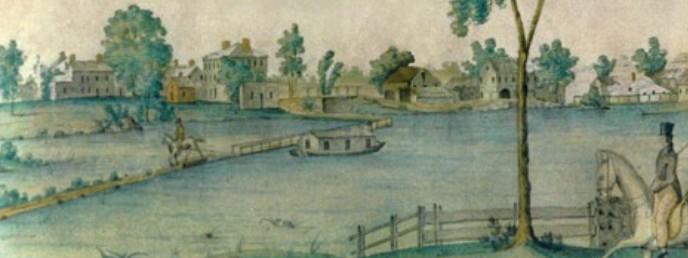


Middlesex Canal Association P.O. Box 333 Billerica, Massachusetts 01821
www.middlesexcanal.org
| Volume 50 No. 3 | March 2012 |
MCA ACTIVITIES
Mark your calendars!
A Middlesex Canal Bicycle Ride will be conducted on Sunday, April 1, along the length of the canal, from Middlesex Village on the north - south to Charlestown.
The MCA-AMC Spring Walk will take place on Sunday, April 15, in North Billerica.
The Annual Meeting will be held at the museum on Sunday, April 29, beginning at 1 PM. Nancy Lusignan Schultz, author of the book "Fire and Roses", will be our speaker. There will also be an election of officers.
See the Calendar, following, for more information on our activities. Also included in the calendar are meetings and tours, sponsored by other organizations, in which you may want to participate.
Please also check our web site periodically, at the URL noted above, which often lists canal-related events and topics of potential interest.
PRESIDENT'S MESSAGE
by J. Jeremiah Breen, jj@middlesexcanal.org
Now is a good time to walk the towpath of the historic Middlesex Canal. With the leaves fallen and the undergrowth withered, all the canal remnants found by Burt VerPlanck and published in his "Middlesex Canal Guide and Maps" are more visible. And if walkers this time of year still can't find a sluice used to drawdown the canal into Content Brook or other remnant, Roger Hagopian is available to answer questions. He walked the proof of the Guide after Burt had to use a wheelchair.
The canal between Gray and Pond Streets in Billerica has as beautiful a prism as that north from Wilmington Town Park, which is one of the cycle of five walks done by Robert Winters and Roger. A photo of the towpath is at www.middlesexcanal.org/photos/graypond. Gray-Pond is private property while the Wilmington walk is on town land and 14 acres given to the Association. Gray-Pond is easier walking as four-wheel ATVs have kept open 2/3s of the one mile between the streets. Plus the canal has water.
Parking off of Gray Street is on Kara Lane, Billerica 01821. The ATV path ends at Pink St, a short street off of Tomahawk Drive off of Pond St. The photo link above has maps. Both Gray and Pond Streets have Middlesex Canal crossing signs.
The land of the canal is owned by Graypond Realty Corporation except for a house on Gray St. See lot_lines.jpg at photo link. Significantly, the majority of the 107 acres is covered by the Shaffer landfill, also known as the Billerica town dump, part of EPA's Iron Horse Park Superfund site. The June 2000 environmental settlement requires the capped landfill be monitored for forty years, i.e., the canal, Gray to Pond St., should be safe from development for forty years. The landfill is being developed for solar electricity with ≤25 acres of photovoltaic panels with money from the sale of electricity put towards the environmental settlement.
Maybe Graypond Realty Corp. does not own the canal. Google's lot lines, link above, shows a canal strip between Graypond and the abutters. The 1966 deed from the Boston and Maine doesn't mention the canal. Maybe it doesn't matter. The Shaffer family, through three brothers named as trustees, control Graypond but Graypond after the environmental settlement is just an owner of record whose property comes with enough liability that Billerica won't take it for non-payment of taxes. As the Shaffers control Graypond but have no benefit from it, the present is a good time to ask them to grant the Association an easement along Graypond's southern property line. With such an easement, the annual bike ride would be on or near the towpath for the mile between Grey and Pond Streets and more than a mile of travel on busy Route 129 would be eliminated.
Sunday, April 1st, Dick Bauer and Bill Kuttner will be leading a bike ride in reverse of the annual October ride. Whether or not use is made of the towpath between Gray and Pink Streets as traveled by the ATVs, the April ride, described in another part of Towpath Topics, has the advantage of the cycling starting in Lowell after the Boston train arrives at 10:43 with much better parking available there than in Boston. Rider could also join the Boston leaders at any train station between North Station and Lowell, say 10:23 at Anderson/Woburn off of I-95/128.
If you can say Welcome!, you can be a volunteer at the museum. Simply come to the museum prepared to greet visitors at the reception desk. An experienced docent will be present to answer questions.
J. Jeremiah Breen
TABLE OF CONTENTS
MCA Activities
President's Message (J.J. Breen)
Calendar of Events
Baldwin & the Great Seal (Tom Raphael)
Harvesting Canal Ice (Bill Gerber & Susan Williams)
Chelmsford (Bill Gerber)
It Was a Family Thing (Bill Gerber & Susan Williams)
Passports (Bill Gerber)
Miscellany
CALENDAR OF EVENTS
Middlesex Canal Association (MCA) and related organizations
First Wednesday - MCA Board of Directors' Meetings - The Board meets at the Museum, from 3:30 to 5:30pm, the first Wednesday of every month, except July and August. Members are always welcome to attend.
Sat, Mar 31, 2012 - Lock Tender Training, conducted by Lowell Parks and Conservation Trust, supporting Concord River Whitewater Rafting. To be held at 10 AM at the UMass Lowell Inn & Conference Center, 50 Warren Street, Lowell MA. Learn to operate a "real" lock! Training is conducted at Warren Locks on the Pawtucket Canal (aka Lower Locks and Concord Locks). Volunteer lock tending shifts are Saturdays and Sundays thru April and May and last from 10:30 AM to 12:00 PM and 2:30 PM to 4:00 PM. Proper training and a signed release form are required for all lock tenders. For further information - Gwen Kozlowski, Stewardship & Education Manager <gwen at lowelllandtrust.org>, Mon. to Thurs., 8:30 AM to 4:30 PM.
Sun, Apr 1, 2012 - Spring Middlesex Canal Bicycle Ride. Meet 9:30 AM at North Station (commuter rail) and take our bicycles on the 10 AM train to Lowell. (Riders can also board at West Medford at 10:11 or meet the Train when it arrives in Lowell at 10:43). Route visits the Pawtucket and other Lowell canals, the river walk, Francis Gate, and then Middlesex Canal remnants in Chelmsford. Lunch at Route 3A mini-mall in Billerica. Quick visit to Canal Museum, then on to Boston. Long day, but sunset is late. Riders needing to leave early can get the train to Boston at 1:07 at North Billerica or at 3:14 at Wilmington. Participants are responsible for one-way train fare [$6.75 from Boston to Lowell]. Complete Lowell line schedules can be downloaded at www.mbcr.net if anyone wishes to plan a rail travel itinerary specific to their needs. For any changes or updates, see www.middlesexcanal.org. Leaders Bill Kuttner (617-241-9383) & Dick Bauer (857-540-6293).
Apr 7, 2012 - Canal Society of New Jersey. Walk the Delaware and Raritan Canal from Upper Ferry Road to the northern end of Titusville (5 miles), at the junction of River Drive and Route 29. Features of this walk include a turning basin, a bridge tender's house, several culverts and two spillways. Meet at the intersection of River Drive and Route 29 (just south of Fiddler's Creek Road). Questions? Call Bob Barth, 201-401-3121 or email <barth at att.net>.
Apr 13-15, 2012 - Canal Society of Indiana 30th Anniversary Tour, headquartered in Batesville, IN. Bus & Whitewater Valley Railroad tour of Whitewater Canal locks and dam (Connersville to Brookville). Visit Whitewater Canal headquarters, Gateway Park, Yellowbank Lock 21, railroad shops and yard. Meals at historic Laurel Hotel and Sherman House. Teddy Roosevelt re-enactor on NY and Panama canals. Leaders are Bob & Carolyn Schmidt, <indcanal at aol.com>.
Sun, Apr 15, 2012 – Joint MCA-AMC Middlesex Spring Canal Walk, N. Billerica. (rain date Sun, Apr 22) Level 5-mi. walk along historic canal N to Chelmsford, 1:30-4pm. Meet at the Middlesex Canal Museum (opens at noon). From Rt. 128/95, take Route 3 toward Nashua, to Exit 28 "Treble Cove Road". End of ramp, turn L toward North Billerica. At about ¾ mile, bear L at a fork. At traffic light, cross over Route 3A. Go thru "S" to a 3-way fork; take Talbot Street (straight ahead, which puts St. Andrew's Church on your left). Go about ¼ mile and bear R onto Old Elm Street, which becomes Faulkner Street. Go about ¼ mile to the falls at the dam; the Museum is on your left, park across the street. No registration required. Info: www.middlesexcanal.org or Roger Hagopian (781-861-7868 to 10pm). L Robert Winters (617-661-9230; <Robert at rwinters.com>).
April 20-22, 2012 - Pennsylvania Canal Society Spring Field Trip, will explore the Delaware & Hudson Canal. Contact: Bill Lampert, indnbll at yahoo.com.
Sun, April 29, 2012 - MCA's Annual Spring Meeting will take place in the museum, at 1:00 PM. Nancy Lusignan Schultz, author of the book "Fire and Roses", the story of the 1834 burning of the Ursuline Convent and School in Charlestown, the target of a violent anti-Catholic riot in 19th century Massachutts, will be our speaker. Election of officers for the forthcoming year will occur at that time. Refreshments will be provided following the meeting.
Directions to the Museum/Visitors Center: Telephone: 978-670-2740.
By Car:
From Rte. 128/95, take Route 3 toward Nashua, to Exit 28 "Treble Cove Road, North Billerica, Carlisle". At the end of the ramp, turn left onto Treble Cove Road toward North Billerica. At about ¾ mile, bear left at a fork. After another ¾ mile, at a traffic light, cross straight over Route 3A. Go about ¼ mile to a 3-way fork; take the middle road, Talbot Street, which will put St. Andrew's Church on your left. Go about ¼ mile and bear right onto Old Elm Street. Go about ¼ mile to the falls, where Old Elm becomes Faulkner Street; the Museum is on your left and you can park across the street on your right, just beyond the falls.
From I-495, take exit 37, N. Billerica, south to the road's end at a "T" intersection, turn right, then bear right at the Y, go 700' and turn left into the parking lot. The Museum is across the street.
By Train: The Lowell Commuter Line runs between Boston's North Station and Lowell's Gallagher Terminal. Get off at the North Billerica station, which is one stop south of Lowell. From the station side of the tracks, the Museum is a 3-minute walk down Station and Faulkner Streets on the right side.
May 4-6, 2012. Virginia Canal & Navigation Society (VC&NS) Annual Canal Conference, Covington, VA. Celebrate the Bicentennial of Chief Justice John Marshall's 1812 survey over the Alleghany (sic) Mountains to connect navigation on the James River with the Ohio River via the Kanawha Canal. This route would ultimately become the C&O Railway's route. The VC&NS and the C&O (Railway) Historical Society & Archives are partners for this grand event.
Phil de Vos, <phipfox at yahoo.com> or www.vacanals.org.
May 5, 2012 - Heritage Trail Association Bus Tour along the D&R Canal in Somerset County, NJ, with stops at Griggstown, Rocky Hill and Kingston. $10/person. Register online at www.heritagetrail.org or call 732-356-8856. L. Bob & Linda Barth.
June, 22-24, 2012 - The Canadian and the American Canal Societies' Historic Canals Conference, ACS Annual Meeting, and CSNY Field Trip, Hamilton, Ontario - will examine the Desjardins Canal (which will be celebrating its 175th anniversary), the Burlington Ship Canal, and Hamilton Harbor and its environs. Registration & Information at www.canadiancanalsociety.org "Events". L. Bob Sears, 416-285-7254; <dawnofdestiny at sympatico.ca>.
June 30, 2012 - Canal Society of New Jersey, Waterloo Canal Day at Waterloo Village. Music, boat rides, games, displays, tours. 11-5. Free, but donations are welcomed. Also Canal Heritage Days will be held at Waterloo on the 2nd and 4th Saturdays in July, August, September and October. L. Brian Morrell,
<bmorrell at citybloom.org> or www.canalsocietynj.org.
Sept, 25-27, 2012 - World Canals Conference, Yangzhou, China. See www.worldcanalsconference.org for details.
Sept 14-16, 2012 - Canal Society of Indiana - Fall tour on the Hennepin Canal, Headquartered in Moline, IL. dinner cruise aboard the Celebration Bell on the Mississippi River, locks and lift bridges. L. Bob & Carolyn Schmidt, <indcanal at aol.com>.
Sept 30 - Oct 2, 2012 - Canal Society of New York State Canal Conference, Oswego, New York. For details www.newyorkcanals.org.
Oct 3-15, 2012 – Canal Society of New York - Canals and Waterways of Belgium – For details, visit www.newyorkcanals.org.
Oct 19-22, 2012 - Pennsylvania Canal Society's tour of the Union Canal. Contact: Bill Lampert, <indnbll at yahoo.com>.
Sept, 2013 - World Canals Conference in Toulouse, France.
See www.worldcanalsconference.org for details.
THE EYE OF WISDOM
Loammi Baldwin and the GREAT SEAL
By Thomas Raphael
As he turned the first shovel of earth, on September 10, 1795, to start the construction of the Middlesex Canal, Loammi Baldwin was quoted as praying, "May the Eye of Wisdom and the Eternal Mind aid this work designed for the benefit of this and all Future Generations". He was followed by James Winthrop and Samuel Jaques, each offering a short prayer as they turned a shovel of earth. To me, this would appear to be highly practical and scientific, we observe the truth and record the knowledge, in the mind or in books. It would be easy to represent that statement, as an "eye' over some symbol of knowledge such as a pile of books or a structure.
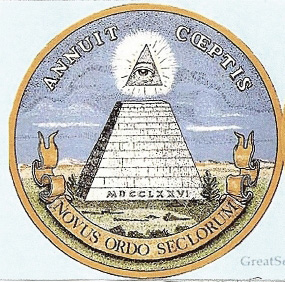
In 1782, a written statement, describing a Great Seal of the United States, but no specific art work, was approved by Congress. It was described as "the Eye of Providence and an Unfinished Pyramid". It appears on the reverse of one dollar bills. The founding fathers seemed to avoid using "God", and they used the unfinished pyramid, made of 13 layers, to represent the 13 colonies as the beginning of a new, growing society.
Thomas Jefferson, in 1800, ended his inaugural address with, "May the Infinite Power which rules the Destinies of the Universe lead our counsels to what is best and give them a favorable issue for your peace and prosperity".
It seems coincidental, but there may be more to it than we realize. I admit it is not wise to speculate, but the similarity of the three statements provides some insight to the minds of our founders. They avoided the outright religious phrases and the guidance of a deity. They also knew the value of learning and of building on the past and, therefore the importance of education.
It is also consistent with the freedom of religion the Pilgrims and Puritans practiced. They believed that everything was preordained by God so there is no invoking of his name. They believed only in baptism and the Last Supper, that prayer is spontaneous and not to be recited, and sang only hymns of biblical psalms. Marriage was a civil, not a religious matter. They built very plain churches, which were used also as meeting houses, where all should gather and together establish their societies with elders and a preacher, but no vestments, mass, idolatry, crosses, statues or stained glass windows. They had no doctrines, they believed in leaving each to their own interpretation of the Bible, their "freedom of expression".
It would appear to describe the men who were the builders of the canal.
HARVESTING CANAL ICE
by Bill Gerber
In early 1820, James Fowle Baldwin succeeded John Langdon Sullivan as agent for the Middlesex Canal Corporation. James was a son of Loammi Baldwin and was later employed as engineer and constructor of the Boston & Lowell Railroad. With this change in leadership came changes in policy regarding the way in which the canal was managed. One change was to the obscure policy of harvesting canal ice.
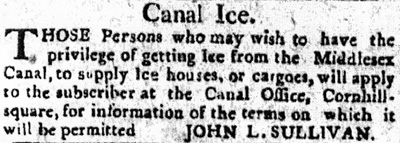
In January, 1812, Sullivan posted a notice in The Repertory1 that read: "Canal Ice, Those Persons who may wish to have the privilege of getting ice from the Middlesex Canal, to supply ice houses, or cargos, will apply to the subscriber at the Canal Office, Cornhill square, for information of the terms on which it will be permitted."
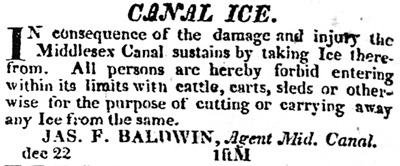
Baldwin obviously disagreed with Sullivan's policy. In December, 1821, he posted a notice in the Centinal2 that read: "Canal Ice. In consequence of the damage and injury the Middlesex Canal sustains by taking Ice therefrom. All persons are hereby forbid entering within its limits with cattle, carts, sleds or otherwise for the purpose of cutting or carrying away any Ice from the same."
Considering that ice was harvested from most of the local ponds, it seems unlikely that loss of the canal as a source made much difference to the industry; but local ice merchants were probably not happy.
References:
1. Advertisement; The Repertory and General Advertiser, Vol. IX, Issue 4, P-4; January 14, 1812, Boston, Mass.
2. Advertisement; Columbian Centinel, Issue 3936, p-4; December 29, 1821; Boston, Mass.
CHELMSFORD
by Bill Gerber
An interesting little book quietly appeared at the recent Chelmsford WinterFest, held over the February 3-5 weekend. Titled "Chelmsford"; it was created by Tom Ryan under a grant from the Chelmsford Cultural Council. In booklet form, it is composed of one very long poem, 35 pages, interspersed with child and folk-art illustrations, that chronicle the history of the town.Several verses tell about the Middlesex Canal, as follows:
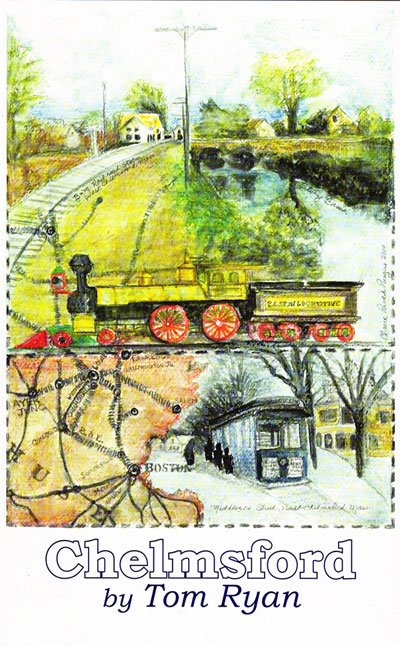 "Investors and bold engineers
"Investors and bold engineers
With wisdom and foresight rare
Built the Middlesex Canal
From Chelmsford to Haymarket Square"
"Along the busy canal
Came people and all types of goods
Down the river from Concord
Came logs from New Hampshire woods."
"Products of the glass works
Went to Boston by boat
Not to worry about breakage
When Chelmsford Glass could float."
"At the fine old Middlesex Tavern
Boat passengers would alight
Where they could board a stagecoach
Or get food and rest for the night."
"The canal carried Chelmsford granite
Which was used in building its locks
It was floated into Boston
For buildings, walls and dry-docks."
"Fletcher's white granite was famous
And used for many things
A Bullfinch building at Harvard
And the graceful state house wings."
That's almost the end of the canal-related verses; but then, about four pages later, Ryan notes:
"The Boston and Lowell Railroad
To Chelmsford was a friend
Hauling its freight and people
But causing the old canal's end."
He just had to say it!!
The book is available from members of the Chelmsford Cultural Council; Kathy Cryan-Hicks, chairperson for the Cultural Council, is one source. Her office is among the Library's administrative section. A $5 donation is suggested.
THE MIDDLESEX CANAL — IT WAS A FAMILY THING
by Bill Gerber and Susan Williams
When I first became interested in the M'sex Canal, one of the early stories told to me was how Loammi Baldwin (the Colonel) and his friend Benjamin Thompson (who would later become known as Count Rumford) would travel from Woburn, Massachusetts, to Cambridge, sometimes on foot, to attend lectures in Experimental Philosophy at Harvard College. Then, upon their return, how they would build models and conduct some of the experiments introduced in the lectures. Although their paths diverged radically during the American Revolution, apparently these activities had great influence on the later lives of both men. Fred Lawson first told me this story, and in his book The Middlesex Canal, Christopher Roberts also tells it3 as does Mary Clarke in her book4. Neither author mentions how these two men, a decade apart in age, came to know each other.
Recently, by a stroke of good fortune, Tom Raphael met Susan Williams, a distant Richardson-Baldwin-Fowle-Bacon-Tidd cousin, who enjoys genealogical research. Susan strives to learn enough about her ancestors and distant cousins to get a glimpse of their lives and occupations. To her, this brings an understanding of history, and makes past times come alive.
The chart (below) summarizes a portion of Susan's research. It reveals that Loammi Baldwin and Benjamin Thompson, through Benjamin's mother, Ruth Simons, were cousins, Second Cousins, Once Removed (2C1R), to be exact. Thus, it seems quite likely that the two men would have known each other through their familial ties as well as through the proximity of their lives in Woburn.
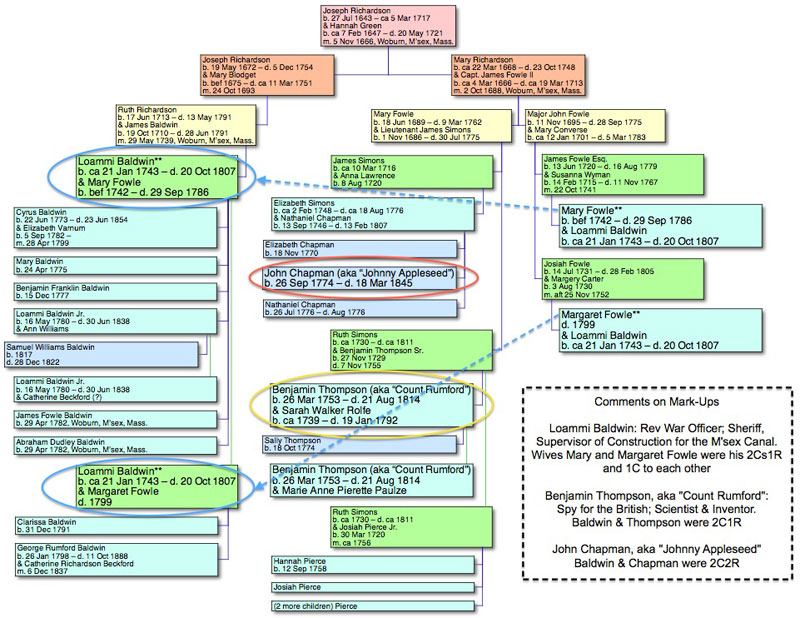
There are other interesting relationships that arise from Susan's research, also shown on the chart. Col. Loammi Baldwin married a 2C1R, Mary Fowle, and by her fathered six children - Cyrus, Mary, Benjamin Franklin, Loammi Jr., and the twins James Fowle, and Abraham Dudley. A few years after Mary died, in 1786, Loammi married another 2C1R, Mary's 1C Margaret Fowle, and by her had two more children - Clarissa and George Rumford. When we talk about the American engineering dynasty begun by Loammi Baldwin, which usually includes Loammi Jr., James and George, George was the half-brother of the other two.
A note of caution: The information about Abraham Dudley Baldwin is "thin" and may be erroneous. He appears in an early genealogy of the Baldwin Family but not in any of the canal-related documentation. It may be that he was a child who died young.
How generations work: Parents make up the first generation their children are siblings to each other...and share parents The 'removed' – The child of your first cousin is your first cousin once removed; i.e., down (removed) a generation from your first cousin. The grandchild of your first cousin is your first cousin twice removed; again, your first cousin and down (removed) two generations. It works the same in both directions. If you are first cousin once removed to someone, they are first cousin once removed to you as well. E.g., Re: http://sonic.net/~fredd/cousins.html |
There's a somewhat silly observation that can be made from the chart. Because he married, in succession, his 2Cs1R, first Mary and later Margaret, Loammi was, in fact 2C2R to all of his own children! Such are the perils of inter-family marriages, and actually, these inter-relationships are even more convoluted! [Does anyone remember the song "I'm my own grandpa"? Listen, and follow the logic, if you can, at http://www.youtube.com/watch?v=eYlJH81dSiw. (Sorry, couldn't resist!)]
But that's not the end of it, there are several more interesting names and relationships that show up in Susan's research. As noted, Loammi was the 2C of Benjamin Thompson's (Count Rumford's) mother. Benjamin's father, (Benjamin Sr.), was Loammi's more distant 3C. And Benjamin Sr., in turn, was the 1C of Samuel Thompson (not shown), a Proprietor of the M'sex Canal Company, as was Loammi. A respected surveyor of his time, a 1793 entry in Samuel Thompson's diary read: "Diarist surveyed Medford River and Pond, the Symmes and Richardson Rivers, and to Wilmington and Billerica, for the newly chartered Middlesex Canal." 5
The historical record suggests that Samuel Thompson probably conducted the last survey before the British canal engineer William Weston, assisted by Loammi Baldwin and several of his sons, conducted the final definitive survey in the summer of 1794. Why was this final survey needed? The Weston-Baldwin survey introduced the "Y-level", an instrument for measuring elevations to a degree of accuracy unattainable by earlier available means. It introduced a major technological advance to the art of surveying, and it found substantial elevation measurement errors in the earlier efforts. This proved indispensable to the construction of this canal and others to follow, and later also to the construction of railroads and many other civil engineering projects.
As also shown on the chart, John Chapman, who later became known as "Johnny Appleseed" was Loammi's 2C2R. His life roughly paralleled that of Loammi's children. What influence did discovery and cultivation of the Baldwin Apple have on the activities of his later life? Among the many orchards he established, how many, if any, produced Baldwin Apples? (Quite possibly, more than a few!) The tradition is that it was Samuel Thompson who, while surveying, first observed woodpeckers pecking away at apples of an unknown species. Thompson called them the Woodpecker Apple but later they were renamed for Loammi Baldwin.
That Loammi's grandmother was Mary Blodget immediately raised another question - what relationship was she, if any, to Judge Samuel Blodget the entrepreneur who built a canal around Amoskeag Falls at what is now Manchester, NH? This question prompted Susan to do additional research, God bless her, which eventually revealed that the two men share the same great-grandparents; thus they were 2Cs (i.e., second cousins). This relationship can be seen in the chart below.
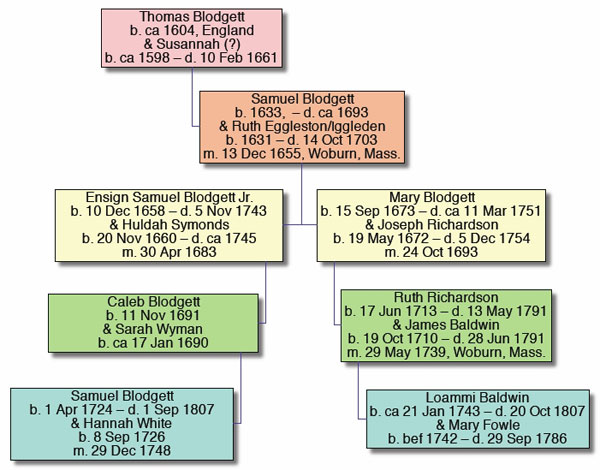
That Baldwin and Blodget were cousins casts a somewhat different light on a late-in-life endeavor of the two men. In about 1794, Blodget began constructing a canal at Amoskeag Falls. It may be that his initial intent was a modest one, to safely transport timber down the falls. But when his concept for an autonomously functioning sluice proved unworkable, he replaced it with a more traditional lock canal. However, in 1798, Blodget's first attempted to open his canal met with disaster. Upon letting water into the locks, the wooden sides were lifted by the upward pressure of the water, the locks disintegrated and were carried away, and "the work of the season was the wreck of the moment ... thus the labor of five years was brought to naught."
In December, 1798, following authorization by the New Hampshire legislature, Blodget called upon his cousin Loammi, by then a well respected engineer, to design a replacement canal and to estimate the cost to complete the work. Baldwin delivered a favorable report, but he also recommended a route for the canal to the east of the old one. By this time, Blodget's finances were almost depleted and the effort to rebuild the canal ran into unexpected difficulties. Blodget and Baldwin had a serious falling out over this; it's said that, at one point, the two old men came to blows. Nevertheless, in June 1807, the canal finally opened and Blodget was able to ride through in triumph. This was just in time, he died in early September; Baldwin followed him in late October.
Cyrus Baldwin, who accompanied his father and William Weston on the definitive survey of the M'sex Canal, later became known as the "lock keeper" at Middlesex Village, the northern terminus of the canal; although he was more likely the canal company's business manager there. Cyrus married Elizabeth Varnum. Another question: did Cyrus find his wife from among the Varnums who established themselves in Dracut, immediately across the Merrimack River from M'sex Village and at the far end of Clark's Ferry? Dracut was also the site of one of the three canal Landings initially established beyond the northern terminus of the Middlesex Canal (the others being at Tyngsborough and Nashua), so Cyrus might well have had good reason to cross the river frequently.
Furthermore, what was Elizabeth's relationship to Parker Varnum, who, in 1794 accompanied Loammi Baldwin on a survey of six falls/rapids below Pawtucket Falls on the Merrimack River for the "Proprietors of Locks and Canals on Merrimack River"; and to Colonel James Varnum, who supervised the "improvements" to these same rapids a year or two later?
Again, Susan went researching and came up with the answers, summarized in the chart below.
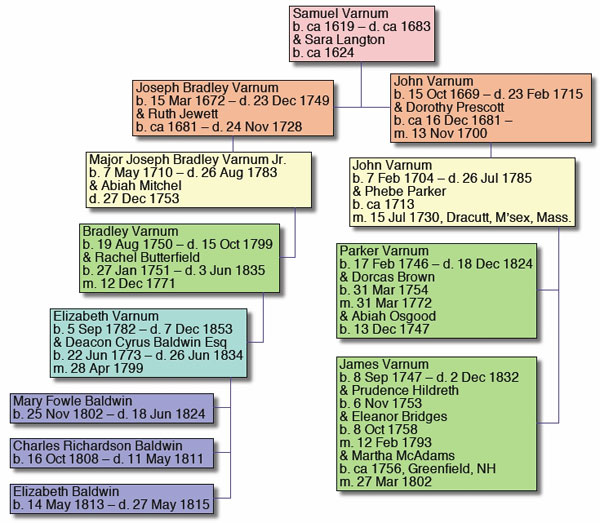
Yes, almost certainly, Cyrus did find Elizabeth among the Dracutt Varnums. And they married around the time that the northern branch of the M'sex Canal was opened, suggesting that they were courting while that portion of the canal was still under construction, and well before there was a functioning Landing anywhere, much less in Dracutt.
Regrettably, their marriage knew great sorrow. Their oldest daughter died at age 21 of a fungal infection. Their son drowned in the canal while he was still a toddler. And their third child, a daughter, also died young.
As for Parker and James Varnum, as the chart shows, they were brothers, and both had a close association with water transportation, though primarily with that on the Merrimack River, specifically improvement to the falls/rapids thereon. And yes, Elizabeth (Varnum) Baldwin was related to these brothers. Their great-grandparents were her great-great-grandparents, thus they too were 2C1R.
What came first? Did the families devote themselves and their wealth to the canal, or did the building and operating of the canal require the talent of these intelligent and well educated families? These were merchants and farmers, looking to invest in the growth of their new world, as well as to profit from their endeavors. There were not that many of that caliber at that time.
(Charts were prepared and extensively edited using Reunion, a genealogical application for Macintosh computers.)
References:
3. Roberts, Christopher; The Middlesex Canal, p-37.
4. Clarke, Mary Stetson; The Old Middlesex Canal, p-19
5. Diary of Samuel Thomson; The New England Historical and Genealogical Register, for the year 1880, Vol. XXXIV; Boston, Published at the Society's House, David Cliff & Son. 1880
MIDDLESEX CANAL PASSPORTS
by Bill Gerber
Christmas 2008 brought an unusual gift from an unexpected source. 'Out of the blue', Bob Keintz, then President of the Pennsylvania Canal Society, now deceased, and his wife Ryn Agnew sent me an 1805 Middlesex Canal Passport. What a delightful surprise.
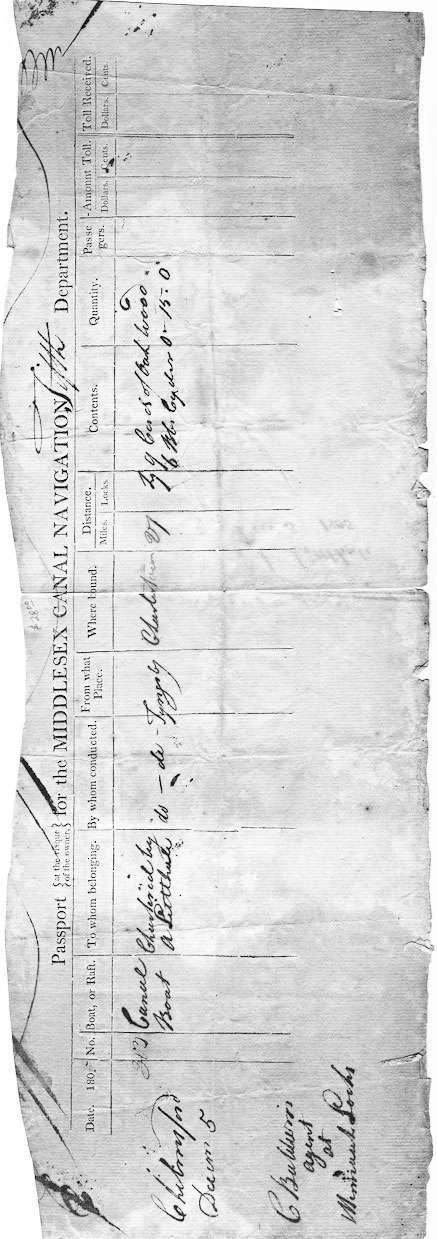 A reduced size grayscale scan of the passport is shown at right. [My thanks to Fred Merriam, Chelmsford Historical Society, for joining two partial scans of a document too large for my scanner.] The original is unevenly yellow from age, about 16" in width and 5.5" in height. Extraneous ink lines and the the wavy upper edge suggest that it was cut from a larger sheet, perhaps from a printed page of blank passports.
A reduced size grayscale scan of the passport is shown at right. [My thanks to Fred Merriam, Chelmsford Historical Society, for joining two partial scans of a document too large for my scanner.] The original is unevenly yellow from age, about 16" in width and 5.5" in height. Extraneous ink lines and the the wavy upper edge suggest that it was cut from a larger sheet, perhaps from a printed page of blank passports.
The top line of print reads: Passport {at the risque of the owner} for the Middlesex Canal Navigation Fifth Department. ("Fifth" is handwritten.) Next there are columns with headers, many of which show handwritten entries. In sequence, with headers bold and entries in italics, these are: Date: 1805; Chelmsford, Decem 5; C Baldwin Agent at Merrimack Locks. No. (likely the boat registration; hard to read, possibly '203'). Boat, or Raft. Canal Boat. To whom belonging. Chartered by A Littlehale. By whom conducted. do — de. From what Place. Tyngsb. Where bound. Charlestown. Distance / Miles / Locks. 27 / (undecipherable but should be 19). Contents. 9 Cord of Oak Wood / 6 Bls Cyder. Quantity 0-15-0. Passengers. Amount Toll / Dollars / Cents. Toll Received / Dollars / Cents. (These last three columns are empty.)
Relevant regulations and statements regarding the use of passports, lifted from Lewis Lawrence's manuscript "The Middlesex Canal", are appended to the end of this article. These, however, are the regulations established by John Langdon Sullivan in 1809. What the earlier regulations were and how they were enforced in 1805 is less clear.
When issued, a Passport would allow passage through a designated section of the Middlesex Canal (in this case, and frequently, the entire length), and serve to bill for the cargo carried. For through-boats, the charges for lockage, the cargo and the distance traveled (and sometimes room and board, and tow animal rental) would be collected at the Charlestown end of the canal, where the boatman was allowed to sell enough goods from his boat to pay his fees.
This Passport indicates that Mr. Littlehale's boat came down the Merrimack River from Tyngsborough, and thus passed through the rapids, adjacent to Wicasee (aka Tyngs) Island (now the site of Vesper Country Club). These rapids, or 'falls' as they were then called, had been 'improved' in about 1795/96 by the Proprietors of Locks and Canals on Merrimack River, the company that built Pawtucket Canal and 'improved' seven of the river's falls/rapids, this one included. No definition or description of "improved" has been found; likely it consisted of clearing a channel of obstructions and perhaps constructing a wing-dam to divert more water into the channel. It would be another two decades before Wicasee Falls would be "canalized".
The cargo noted in the Passport included nine cords of oak wood and six barrels of cyder (fairly common commodities throughout the life of the canal). This was two years after the M'sex opened and long before construction of the river canals was completed; by that time, along the river, only the Pawtucket Canal was operating. (See TT 1/2009.) But notice that this trip took place in early December, 1805. What in the world was Mr. Littlehale doing running on the canal that late in the season? And, he had yet to sell his wares and return home. (But winter, 1805, must have been late or mild, or both; amazingly there's a passport in the corporate records for another trip made two weeks later!).
I don't recognize, and haven't found any information about the boatman, Mr. Littlehale, but the billing was signed by Cyrus Baldwin, Loammi Baldwin's oldest son. He was the lock keeper at Middlesex Village for many years and Baldwin Street, there, is named for him. (Not his father or one of his better known brothers.) Was he still actively involved with canal company business in 1839, when Henry David Thoreau and his brother passed through? Thoreau did comment about the lock keeper being 'contemplative', but Samuel Hadley (father of Judge S. P. Hadley) was the official lock keeper in the village by then. (Regrettably, the site of Baldwin's grand old home is now part of Hadley Park; a comparable fate has befallen much of the rest of Middlesex Village.)
Before ascending to the top of the Merrimack Locks, Mr. Littlehale, would have arranged for an animal to tow his boat down the canal. He may have gone to the canal livery to rent a horse, but since no horse is listed in the billing, he may have rented his tow animal from someone else in the Village.
Mr. Littlehale's boat ascended the Merrimack flight of locks, a three-lock "staircase", to the Concord River level of the M'sex Canal. The river was the summit of the canal, setting a level which extended about 11 miles. As such, this river was also the main source of water for both the canal's north and south-bound branches.
Traveling the entire 27-1/4 mile length of the canal, the boat would negotiate eight levels, connected by two guard locks and a total of 17 lift locks; it would cross sizable streams on eight aqueducts, probably all single lane, and pass under about four dozen accommodation bridges, also single lane, at least three of which doubled as 'change bridges' to move the towpath from one side of the canal channel to the other (see TT 3/2008, "Which Side").
While traveling toward, i.e., 'ascending to' summit level at the Concord River, this freight boat would have had priority over, and therefore authority to pass by, rafts of logs and 'bands of rafts' traveling in the same direction, as well as other freight boats 'descending from' (traveling away from) summit level. However, faster moving Packets (carrying passengers and light freight) would have had priority over Mr. Littlehale's boat. Once past summit level, his boat would still have priority over rafts, but would have been required to yield to other freighters and packet boats ascending. In early December, however, it is unlikely that Mr. Littlehale had to contend with much other traffic.
Given that he came down the river, Mr. Littlehale almost certainly had at least two other men with him to help propel and control the boat on the river. Once on the canal two people could manage, one to guide the horse and the other to steer the boat. However, in 1805, the third person could still be useful, particularly at the Concord River crossing. Until 1809, the floating towpath was not sufficiently robust to take the weight of the tow animal(s). Instead, one of the crew would manually tow their boat across the Concord while another steered. Sequentially or simultaneously, the tow animal would be guided around, either by the fordway (a shallow section of the river, roughly under today's Pollard Street bridge) or over the dam, to be reconnected with the boat on the east side of the river.
Though not so likely in December, if rafts of logs were being towed across the Concord River, Mr. Littlehale's freighter might also have experienced a delay here. The rafts were often towed down the canal in 'bands' consisting of multiple rafts. In 1805, these 'bands' would have to be disassembled into individual rafts to negotiate the guard locks and the river crossing, and would also have been towed by men along the floating towpath, a time consuming procedure and one that often influenced the raftsmen to remain on the river and take their wares to Newburyport, instead of by canal to Charlestown or Boston.
A few years later, in 1808/9, the floating towpath was enlarged and 'raft locks' were constructed here, integral with the guard locks on either side of the Concord River. (See TT 4/2009, What's a Raft Lock?) These consisted of a second set of lower gates positioned about 670 feet from the upper gates of these same locks. On the west side, this modification enabled entire 'bands' to be raised to the level of the Concord River, without requiring disassembly (if the river was, in fact, higher than the east and west branch levels and the guard locks were thus even being used), to be towed across the river to the corresponding raft lock on the east side, there to be lowered to the level of the eastern branch of the canal. For raftsmen, this reduced the time to negotiate this crossing from as much as a day or more, to perhaps an hour or so.
Freighters (aka 'luggage boats'), like Mr. Littlehale's, were allowed to proceed on the canal at 2-1/2 miles per hour, thus the trip would take: about 11 hours of travel time; plus lockage times, maybe 7 or 8 minutes per lock, average, which added another 2 hours or so. Add to this the time spent waiting for other boats, particularly at locks, aqueducts and bridges. In addition, Mr. Littlehale would likely have stopped for at least enough time, perhaps several times, to feed and rest the crew and the tow animal. He may also have stayed overnight in one of the canal-side taverns or lock keepers' houses, since it seems unlikely that he could have completed his trip in one day. While staying overnight, if not too exhausted to do so, Mr. Littlehale would have had an opportunity to socialize with other boatmen, some of the locals, and perhaps some of the tavern or lock keeper's family.
From Charlestown, after paying his 'lockage fees', Mr. Littlehale may have taken his boat through a 20th lock, a tidal lock, from the Charlestown Mill Pond into the Charles River. From there he might have gone over to Boston, or up river to Cambridge or Watertown, perhaps even farther, likely to wherever he thought he could get the best price for his wares.
Rules and Regulations regarding Passports.
Every Boat must have a passport, whether loaded or not."
When any Boat or Raft shall be received into the Canal, the Lock-Keeper shall give the conductor a passport, according to the orders he shall receive from the agent of the Corporation.
"Passports to be produced.
And in navigating the canal, the conductor of every Boat and Raft shall produce his passport to the Lock-Keeper at every Lock to which he shall arrive, whose duty it shall be, immediately to examine the same; and if regular, to endorse his name thereon, and lock the Boat or Raft through. If a regular passport is not produced, such Boat or Raft must be detained until the conductor procures his passport from the head Lock-Keeper, or from the Keeper of the Lock next above where he entered the Canal."
"When the Boat reaches its destination.
When a Boat or Raft arrives at its destination, the conductor shall immediately present his passport to the Collector of the Landing, and not begin to unload until the collector shall designate the spot on which his lading shall be deposited."
"A part landing of the lading.
If a part of the lading or contents of any Boat or Raft shall be landed at one of the intermediate landings, the part or portion so landed shall be endorsed by the Collector on the passport, as well as the amount of toll paid."
"In case of being destined to a private landing.
When any boat or Raft shall be bound to a private landing place, (if any should be permitted) the passport must be expressly to such landing place, the owner paying the toll previously."
"No Boat or Raft to move without a passport.
No Raft or Boat shall be allowed to proceed on the Canal without a proper passport; and if any person shall attempt to move a Boat or Raft thereon without a passport, the Collector or any other Servant of the Corporation shall stop the same, and give information that a prosecution may be had for the penalty provided in such cases by the laws of the Corporation."
"Boats to be marked.
No boat (after the 1st day of May next) shall be received into the Canal, unless the name of the owner be marked thereon with paint, conspicuously, and the Boat numbered (from one to the greatest number owned by the same person) in order that the Boat may be properly designated in the passport."
"No wood or other article
No wood or other article shall be landed at any other place than the established landing places, viz.
The Landing Number One, on the east side of the Mill-Pond in Charlestown.
The Landing Number Two, at the Bason in Charlestown.
The Landing Number Three, at the Bason in Medford.
The Landing Number Four, at the Medford River Lock.
The Landing Number Five, to be established in Woburn
The Landing Number Six, to be established in Wilmington.
The Landing Number Seven, at Concord River.
The Landing Number Eight, at the head of the Canal in Chelmsford.
Unless by express license in writing from the Agent of the Corporation, under the regulations he may establish, nor without security that the banks of the Canal where such landing may be permitted shall not be injured."
"Wood may be loaded in the Canal at, &c.
Wood may be taken into the Canal at other than the established landing places, under the following restrictions and regulations, and on no other condition;
Application shall be made to the Agent for leave; who will give permission in writing, for a limited time, designating the place; on condition that no injury whatever shall be done to the banks or Canal, that no obstruction or hindrance to the navigation of the Canal shall be occasioned thereby.
That the owner or conductor shall obtain a passport for every Boat from the Lock-Keeper next above the place where he loads the wood, and
That he shall pay toll from that Lock.
That the person owning the land from which the wood is loaded into the Canal, and the owner of the wood, if he be a different person, shall sign an obligation to observe these conditions."
"Passport to be delivered.
On arriving at a landing place, where the lading is to be discharged, the conductor of the Boat or Raft will immediately deliver his passport to the Collector, who will assign the spot where to unload; and will take account of the lading or contents and calculate the amount of toll to be paid."
"Penalty for a false passport.
And that if any person shall fraudulently offer, at any lock or landing place on the Canal aforesaid, any false certificate or passport, with an intent to defraud the said Corporation of any toll, or shall receive on the Canal or land from the same, any article at any other place than one of the landing places established as aforesaid, he shall forfeit and pay the sum of five dollars, to be recovered to the use of the said Corporation in manner as the law directs."
Some of the subsequent additional regulations are as follows:
"Manner of Transacting The Canal Business at Landings No. 1 & 2 in Charlestown," April 1809, signed by John L. Sullivan, Agent.
"When any Boat, loaded with wood or other articles, is bound to the Boston Landing, the Conductor must present his Passport to the Collector at Landing No. 1, who will endorse the same, and enter it in a book kept for the purpose. And the Conductor must bring a Certificate from the Collector at the Boston Landing, that his lading has been all received there; otherwise he cannot have a Passport for the Boat to go up the Canal again."
"It may be sufficient to observe, that no boat moves upon the Canal without its passports, specifying every particular of its loading; which passport is produced at every Lock, and endorsed by the Lockkeeper; thus answering the double purpose of checking any imposition that might happen on the part of the boatmen, and of keeping the Lock-keepers always at their stations, which is very important. And no credit being given for the toll, it is either paid immediately, or the property detained for security; and for interest on the toll, after a reasonable time."
Sullivan explained the method of collecting toll thus:
"When a raft is passing Bow Canal, the intendant while locking it through, enters a description of it in his book, and receives from the owner the best report he can get."
"The same is done at Hooksett, six miles lower down the river."
"At Amoskeig, while passing, the Intendant there goes on to the raft, examines, counts and measures it, as accurately as is practicable. This survey is entered in his book, the tolls calculated for each of the canals, and for such of the union locks as the kind of raft, and the state of the river make it necessary to use. If the raft is bound to Newburyport, the toll is paid in cash; if to Charlestown, a note is taken, and the property pledged as collateral security. On reaching Middlesex, a passport is given, descriptive of the raft, and attached to the manifest from Amoskeig. At the office in Charlestown the settlement of the toll is made - if the owner does not sell immediately, he deposits his property in the booms. If it is partially taken out the tolls of the upper canals are first paid, and as much towards the Middlesex, as amply covers the part removed. Then the agent has it in his power to trace the progress of the business, and to see that all is finally collected as he settles the collection accounts periodically."
"Boats ascending or descending have their loading ascertained at the entrance, and at each canal, as occasion may require. Each one carries a passport, to be produced at each lock, and penalties are annexed to the breach of the regulations. - The refusal of a passport, and the prompt institution of a suit before a magistrate when necessary gives a sufficient control over the minds of those who use the canal."
"The lock Keepers are themselves under strict rules, and are obliged to facilitate the passage of the canal on a given signal, at the earliest and latest hours of light."
MISCELLANY
Estate Planning - To those of you who are making your final arrangements, please remember the Middlesex Canal Association. Your help is vital to our future. Thank you for considering us.
Museum & Reardon Room Rental - The facility is available at very reasonable rates for private affairs, and for non-profit organizations' meetings. The conference room holds up to 60 people and includes access to a kitchen and rest rooms. For details and additional information please contact the museum at 978-670-2740.
Masthead - Excerpt from a watercolor painted by Jabez Ward Barton, ca. 1825, entitled "View from William Rogers House". Shown, looking west, may be the packet boat George Washington being towed across the Concord River from the Floating Towpath at North Billerica.
Back Page - Excerpt from an August,1818, drawing (artist unknown) of the Steam Towboat Merrimack crossing the original (pre-1829) Medford Aqueduct.

Towpath Topics is edited and published by Bill Gerber and Robert Winters.
Corrections, contributions, and ideas for future issues are always welcome.